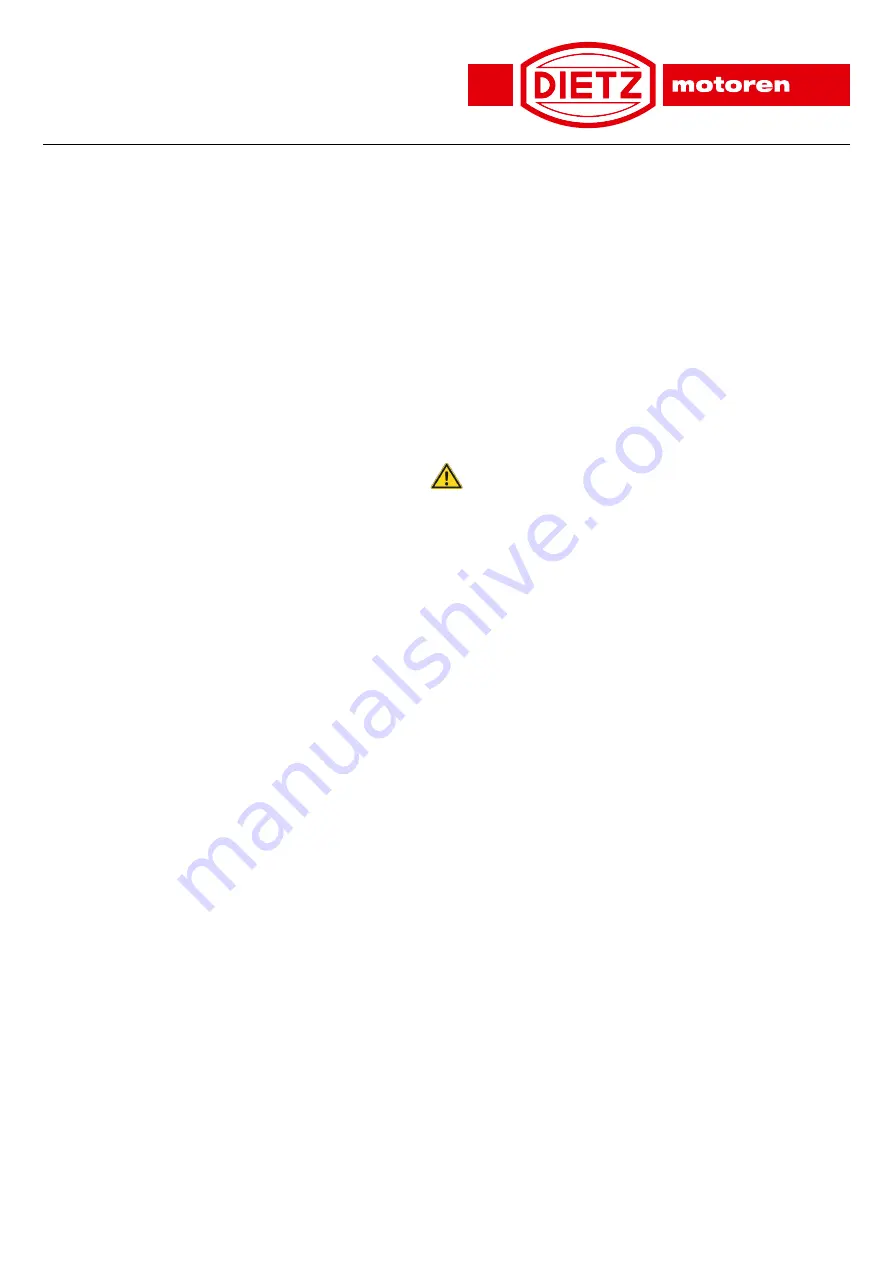
Dietz-motoren GmbH & Co. KG
Eisenbahnstrasse 67 73265 Dettingen/Teck
Tel.: +49 7021 57 02-0
Fax: +49 7021 57 02-14
www.dietz-motoren.de [email protected]
18. Normen
Harmonisierte Normen, unter anderem:
DIN EN 60079-0
DIN EN 60079-1
DIN EN 60079-1
DIN EN 60034-1
DIN EN 60034-5
19. Entsorgung
Die Weiterverwendung von defekten Motoren und/ oder deren
Komponenten kann zu Sach- und Personenschäden, sowie einer
Schädigung der Umwelt führen.
Sämtliche Komponenten des Motors sind entsprechend den nationalen
und internationalen Gesetzen und Vorschriften fachgerecht zu entsorgen.
20. Motoren mit Flüssigkeitskühlung
Bei Motoren mit Flüssigkeitskühlung wird die Verlustwärme über das
Kühlwasser abgeführt.
Folgende Punkte sind dabei zu beachten:
•
Es muss sauberes Kühlwasser, Wasserhärte 1,3 mmol Calcium-
carbonat pro Liter Wasser (max. 7,3°dH), verwendet werden.
Eine Verschmutzung durch mitgeführte Partikel im Kühlwasser muss
gegebenenfalls durch geeignete Filtersysteme verhindert
werden.
•
Zur Vermeidung von elektrochemischen Reaktionen ist auf geeignete
Materialpaarungen zu achten.
•
Die Kühlwasser-Einlauftemperatur beträgt min. 10°C und max. 25°C,
wenn nicht anders spezifiziert.
•
Bei Betrieb oder Lagerung des Motors unterhalb der Frostgrenze
muss ein Gefrieren des Kühlwassers verhindert werden. Hierzu
kann entweder bei Lagerung das Kühlwasser entleert werden, bzw.
für den Betrieb ist ein Frostschutzadditiv zu verwenden.
•
Um Kondenswasserbildung zu unterbinden, muss, wenn die
Kühlmitteltemperatur kleiner als die Raumtemperatur ist, mit
Abschalten des Motors auch der Kühlmittelkreislauf unterbrochen
werden.
•
Der Betrieb des Motors ohne Kühlwasser ist nicht zulässig.
•
Der maximale Wasserdruck beträgt 3,5 bar, wenn nicht anders
spezifiziert.
•
Der Wasserauslauf am Motor ist oben, so dass sich keine Luft im
Kühlsystem ansammeln kann. Eine andere Einbaulage ist nur
zulässig, wenn entsprechend spezifiziert, oder nach Rücksprache
mit dem Werk.
•
Die Kühlwasser-Durchflußmenge beträgt, wenn nicht anders
angegeben:
18. Standards
Harmonised standards including:
DIN EN 60079-0
DIN EN 60079-1
DIN EN 60079-1
DIN EN 60034-1
DIN EN 60034-5
19. Disposal
Continued use of defective motors or their components might cause
physical damage to them, or injury, or harm the environment.
All the motor‘s components must be disposed of professionally in accor-
dance with national and international legislation and requirements.
20. Motors with liquid cooling
Heat in motors with liquid cooling is dissipated via the coolant.
Note the following points:
•
Clean cooling water, hardness 1.3 mmol calcium carbonate per litre
of water (max. water hardness 7.3°dGH), must be used.
•
Suitable filter systems must be used to prevent soiling by particles
carried in the cooling water, if necessary.
•
To avoid electro-chemical reactions, ensure that suitable materials
are paired with each other.
•
Unless otherwise specified, the coolant inlet temperature is min.
10°C and max. 25°C.
•
If the motor is operated or stored at temperatures below zero, the
coolant must be prevented from freezing, either by draining the
coolant while the motor is in storage or by using a frost protection
additive during operation.
•
If the coolant temperature is lower than room temperature, the
coolant circuit must be stopped by switching off the motor, to prevent
condensate from forming.
•
Do not operate the motor without coolant.
•
Unless otherwise specified, the maximum water pressure is 3.5 bar.
•
The water exits the motor at the top so that air cannot accumulate
in the cooling system. It is only permitted to install the motor in other
orientations if this has been specified, or following consultation with
the factory.
•
Unless otherwise stated, the coolant flow quantity is:
Seite 11 von 12
Dokument - Artikel- Nr. 261163
Bitte für künftige Verwendung aufbewahren
Änderungen vorbehalten
Page 11 of 12
Document - Article - No. 261163
Please save for future use
Subject to change






























